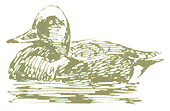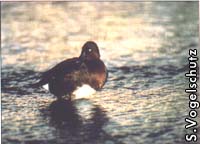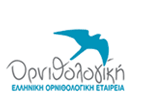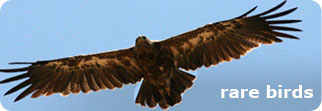 Ferruginous Duck (Aythya nyroca) is a relatively small diving duck (40 cm long), as it dives to obtain its food (insect larvae, molluscs but also aquatic plants). One of the least fancy ducks, it is uniformly dark red-chestnut with a white belly and under tail coverts. When it flies, there is a white patch on the belly and a wide white bar on the wings. Both sexes are almost similar, but drake is distinguished from its most vivid colors and white eye.
Ferruginous Duck (Aythya nyroca) is a relatively small diving duck (40 cm long), as it dives to obtain its food (insect larvae, molluscs but also aquatic plants). One of the least fancy ducks, it is uniformly dark red-chestnut with a white belly and under tail coverts. When it flies, there is a white patch on the belly and a wide white bar on the wings. Both sexes are almost similar, but drake is distinguished from its most vivid colors and white eye.
It prefers calm places in wetlands with rich aquatic vegetation and especially extended reedbeds, broken by patches of open water. In those places, Ferruginous Ducks are hiding and nesting, while they can be also found in small lakes with densely vegetated banks, canals, areas with water lilies and elsewhere.
They are usually seen for a little, either standing on reedbeds’ edges or flying from one opening to the other. During migration and at winter they can be found for a little while in more open areas, in small parties.
Ferruginous Ducks are widely distributed from western Europe and northern Africa to western China. It winters in Africa, south of the Sahara, and at south Asia as far as Bangladesh. However, this large distribution does not correspond to its actual status. Within this vast area, very few are the places with satisfactory numbers of Ferruginous Ducks.
 More usually their numbers are scattered and very small, having seriously declined over the last few decades. In the beginning of the ‘90s their sudden reduction alarmed experts. Their population in the former Soviet Union dropped from 140,000 pairs in 1970, to only 5,200 after 15 years.
More usually their numbers are scattered and very small, having seriously declined over the last few decades. In the beginning of the ‘90s their sudden reduction alarmed experts. Their population in the former Soviet Union dropped from 140,000 pairs in 1970, to only 5,200 after 15 years.
According to some estimates, the world population of Ferruginous Duck may be no more than 50,000 birds or even, for some, 25,000 birds. So, Ferruginous Duck became, from a freely hunted species, to a Globally Threatened Species of BirdLife International.
No one knows with certainty the causes of this decline. There seem to be, however, two important causes. The first one is related with the fact that this species preferred wetlands’ perimeters and small shallow ponds where it nested.
These areas were exactly the most heavily drained, casted and converted. The second cause regards hunting as great numbers were killed easily from hunters which characterized this species as "fool" and easy to be shot at.
In Greece, Ferruginous Ducks used to be common and widespread, but today occurs in very small numbers. It is estimated that no more than 250 pairs breed, most of them in Rodia Marsh, in Amvrakikos, the rest occurring mainly on the wetlands of Ipeiros and Macedonia and very few more south to Peloponnese in Lake Stymfalia. Good sites for this species are Lake Cheimaditis in western Macedonia and Kalodiki Marsh near Parga. At winter, small numbers occur even in Crete and during migration flocks can be observed in Kerkini, Spercheios Delta and elsewhere.
The destruction of habitats in Greece has seriously affected Ferruginous Ducks, while illegal hunting has made things even worse. Some local hunters often enter and hunt inside Rodia Marsh and Kalodiki even during breeding season.
The International Action Plan for Ferruginous Duck gives certain orders for the rescue of this rare species. However, Greek government must do the most important step which must eventually show that the legislation for the protection of wetlands and hunting is for enforcement and not for the filling of some pages.


 Ferruginous Duck (Aythya nyroca) is a relatively small diving duck (40 cm long), as it dives to obtain its food (insect larvae, molluscs but also aquatic plants). One of the least fancy ducks, it is uniformly dark red-chestnut with a white belly and under tail coverts. When it flies, there is a white patch on the belly and a wide white bar on the wings. Both sexes are almost similar, but drake is distinguished from its most vivid colors and white eye.
Ferruginous Duck (Aythya nyroca) is a relatively small diving duck (40 cm long), as it dives to obtain its food (insect larvae, molluscs but also aquatic plants). One of the least fancy ducks, it is uniformly dark red-chestnut with a white belly and under tail coverts. When it flies, there is a white patch on the belly and a wide white bar on the wings. Both sexes are almost similar, but drake is distinguished from its most vivid colors and white eye. More usually their numbers are scattered and very small, having seriously declined over the last few decades. In the beginning of the ‘90s their sudden reduction alarmed experts. Their population in the former Soviet Union dropped from 140,000 pairs in 1970, to only 5,200 after 15 years.
More usually their numbers are scattered and very small, having seriously declined over the last few decades. In the beginning of the ‘90s their sudden reduction alarmed experts. Their population in the former Soviet Union dropped from 140,000 pairs in 1970, to only 5,200 after 15 years.
